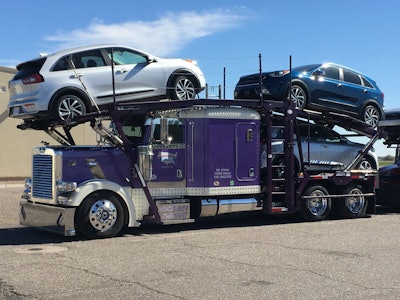 The Federal Highway Administration is considering expanding the definition of auto haulers to include high-mount tractor-trailers that are not able to haul vehicles on the tractor itself.
The Federal Highway Administration is considering expanding the definition of auto haulers to include high-mount tractor-trailers that are not able to haul vehicles on the tractor itself.The Federal Highway Administration is looking to revise the definition of automobile transporter to reduce the regulatory burdens on the industry.
FHWA says automobile transporters are typically defined as “specialized equipment designed and used for the transport of cars” and that car haulers “must be capable of carrying the cars as cargo on the truck tractor itself.”
Current regulations state, “a tractor and semitrailer engaged in the transportation of automobiles may transport motor vehicles on part of the power unit,” and FHWA has interpreted that to mean vehicles that cannot haul cars on the tractor itself are not considered auto haulers. The agency believes it can change its interpretation to include trucks that are not able to carry vehicles on the power unit. It wants to do so without action from Congress.
In order to revise the definition, FHWA is seeking public comment on the possible inclusion of non-cargo-carrying tractor, high-mount trailer combinations as part of the definition. The agency says expanding the definition would eliminate standard length restrictions for these trucks so they can transport additional vehicles and operate more efficiently.
Defining the high-mount combination as an automobile transporter would trigger the use of the same length allowances that currently apply to a traditional automobile transporter, and no state would be able to impose a length limitation of less than 65 feet, a front overhang of less than 3 feet or a rear overhang of less than 4 feet.

FHWA is asking commenters to answer the following questions in their comments:
- How will the inclusion of a high-mount tractor-trailers in the definition impact the flow of interstate commerce?
- Are there safety issues with high-mount tractor-trailers as it relates to the operation of this vehicle configurations?
- What are implementation implications, such as roadside enforcement and changes to state laws?
- What state laws are currently in place regarding a high-mount tractor-trailers?
- Are there states that allow the high-mount tractor-trailers to operate under the same length provisions as traditional automobile transport?
- Is there any other information relating to safety, vehicle productivity or infrastructure preservation relevant to these questions?










